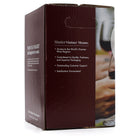Cabernet Sauvignon Wine Kit - Master Vintner® Winemaker's Reserve®




Cabernet Sauvignon Wine Kit - Master Vintner® Winemaker's Reserve®
SKU 41921
PRICE AS CONFIGURED:
$119.99Product Details
Master Vintner® Cabernet Sauvignon makes six gallons of medium-bodied wine with moderate tannins, featuring savory notes of dark, dried fruit behind aromas of ripe plum and vanilla. Wonderfully complex flavors of currants, blackberry, and chocolate burst from this crowd-pleasing wine. Master Vintner® Cabernet Sauvignon gains depth and complexity with aging, developing an aroma of peppery-spice that melts into flavors of smoked cedar, coffee, and tobacco.
Yield: 6 gallons
Additional Information
| Support Documents |
|
| SKU | 41921 |
| Wine Color | Red |
| Wine Style | Cabernet Sauvignon |
| Yield | 6 Gallons |
| Food Pairings | Roast Beef, Barbecue Ribs. |
I've been making wine for decades but never from a kit: seems like cheating somehow. But I'd heard good things about the Master Vintner's kits so I decided to give one a try. At $119 the price was pretty good. Besides, I like Cabernet Sauvignon. I added a few things to get the order up to the "free shipping" level, and upon delivery (about a week wait) got busy.
The instructions were pretty specific and easy to follow. I did deviate a bit though: the recipe (as I recall) if followed exactly, gives an ABV result in the neighborhood of 11%. However I wanted a yield of more along the lines of 14%, so I added enough sugar to get the hydrometer reading on the must before fermentation to a bit over 1.10 and got things going, following the instructions faithfully. That was in August. Just bottled it up last week (3rd week in October) and it tasted great. But it was what happened between "getting things going" and "bottling" that was interesting. Just some hints...
1. As was fermenting only juice I figured my 7 gallon plastic fermenter was the ideal size. Wrong!! Once the fermentation kicked into gear it resembled Vesuvius on a bad day and stayed that way for a good week. I'd fermented a lot of fruit wines (both juice only and juice with solids) but never had one ferment like this. I used one of those large "S" shaped traps in the cover of the fermenter expecting to see the usual parade of bubbles. But this was more like a hiss. It took maybe two days for the fermentation to get into high gear and by then it was shooting pink foam out through the airlock, mightily antagonizing my wife who is not wild about pink-stained countertops. The remedy was to divide up the fermentation: I left about 4 gallons in the fermenter and put the remaining two gallons into a smaller vessel to ferment, combining them only when the fermentation slowed. Moral...you're going to need a primary fermenter significantly larger than 7 gallons.
2. The kit included oak "chips". However the chips were more like sawdust so I substituted one of those oak spirals (Midwest sells them) instead. Maybe 6" long or so. I put it on a string and left it in the primary fermenter. I'm not a big fan of oak: in my experience some winemakers seem to use heavy oak to mask an inferior wine, but I do realize it has it's advantages. I put it in the secondary fermenter and left it there until the first racking. Seemed like the perfect amount of oaking.
3. When adding the stabilizer and clarifier don't be surprised if there is a faint chemical taste to the wine if you taste it immediately after adding. But that was gone pretty quickly.
4. The instructions seemed, as far as the entire process was concerned, to be "best case" scenario; that one racking of the secondary fermentation before bottling is enough. It isn't. I racked twice after transferring it to the secondary carboy and there was sediment both times: A lot after the first racking, a moderate amount after the second. About a month after the second racking the wine had cleared pretty well, and the fermentation had stopped, so I bottled it. But I've learned over the years not to rush things.
BOTTOM LINE: My wife's analysis after we polished off a bottle a couple of nights ago was that this "was the best Cabernet Sauvignon I've ever tasted". She's usually not too liberal with her compliments, but it IS good. I think after a year or so aging in the bottle it will be even better.
I love this wine, one of my favorite red wine kits!
Excellent! Great yeast
Amazing taste, I'll never buy wine from another store. Making it from this kit is more rewarding and blows away the taste of any other wine you can buy at your local store. The best wine I have ever tasted and will continue to order this in the future.
Cabernet Sauvignon Wine Kit - Master Vintner® Winemaker's Reserve®
I've been making wine for decades but never from a kit: seems like cheating somehow. But I'd heard good things about the Master Vintner's kits so I decided to give one a try. At $119 the price was pretty good. Besides, I like Cabernet Sauvignon. I added a few things to get the order up to the "free shipping" level, and upon delivery (about a week wait) got busy.
The instructions were pretty specific and easy to follow. I did deviate a bit though: the recipe (as I recall) if followed exactly, gives an ABV result in the neighborhood of 11%. However I wanted a yield of more along the lines of 14%, so I added enough sugar to get the hydrometer reading on the must before fermentation to a bit over 1.10 and got things going, following the instructions faithfully. That was in August. Just bottled it up last week (3rd week in October) and it tasted great. But it was what happened between "getting things going" and "bottling" that was interesting. Just some hints...
1. As was fermenting only juice I figured my 7 gallon plastic fermenter was the ideal size. Wrong!! Once the fermentation kicked into gear it resembled Vesuvius on a bad day and stayed that way for a good week. I'd fermented a lot of fruit wines (both juice only and juice with solids) but never had one ferment like this. I used one of those large "S" shaped traps in the cover of the fermenter expecting to see the usual parade of bubbles. But this was more like a hiss. It took maybe two days for the fermentation to get into high gear and by then it was shooting pink foam out through the airlock, mightily antagonizing my wife who is not wild about pink-stained countertops. The remedy was to divide up the fermentation: I left about 4 gallons in the fermenter and put the remaining two gallons into a smaller vessel to ferment, combining them only when the fermentation slowed. Moral...you're going to need a primary fermenter significantly larger than 7 gallons.
2. The kit included oak "chips". However the chips were more like sawdust so I substituted one of those oak spirals (Midwest sells them) instead. Maybe 6" long or so. I put it on a string and left it in the primary fermenter. I'm not a big fan of oak: in my experience some winemakers seem to use heavy oak to mask an inferior wine, but I do realize it has it's advantages. I put it in the secondary fermenter and left it there until the first racking. Seemed like the perfect amount of oaking.
3. When adding the stabilizer and clarifier don't be surprised if there is a faint chemical taste to the wine if you taste it immediately after adding. But that was gone pretty quickly.
4. The instructions seemed, as far as the entire process was concerned, to be "best case" scenario; that one racking of the secondary fermentation before bottling is enough. It isn't. I racked twice after transferring it to the secondary carboy and there was sediment both times: A lot after the first racking, a moderate amount after the second. About a month after the second racking the wine had cleared pretty well, and the fermentation had stopped, so I bottled it. But I've learned over the years not to rush things.
BOTTOM LINE: My wife's analysis after we polished off a bottle a couple of nights ago was that this "was the best Cabernet Sauvignon I've ever tasted". She's usually not too liberal with her compliments, but it IS good. I think after a year or so aging in the bottle it will be even better.
I love this wine, one of my favorite red wine kits!
Excellent! Great yeast
Amazing taste, I'll never buy wine from another store. Making it from this kit is more rewarding and blows away the taste of any other wine you can buy at your local store. The best wine I have ever tasted and will continue to order this in the future.
Cabernet Sauvignon Wine Kit - Master Vintner® Winemaker's Reserve®




